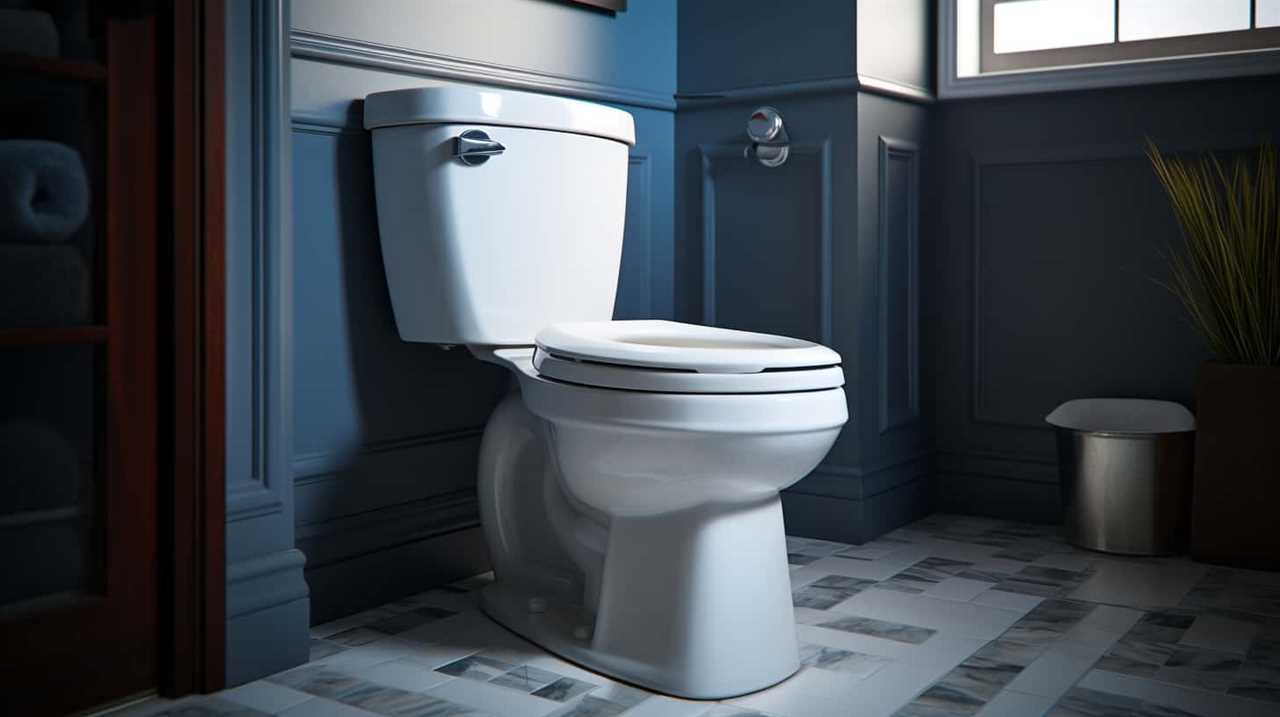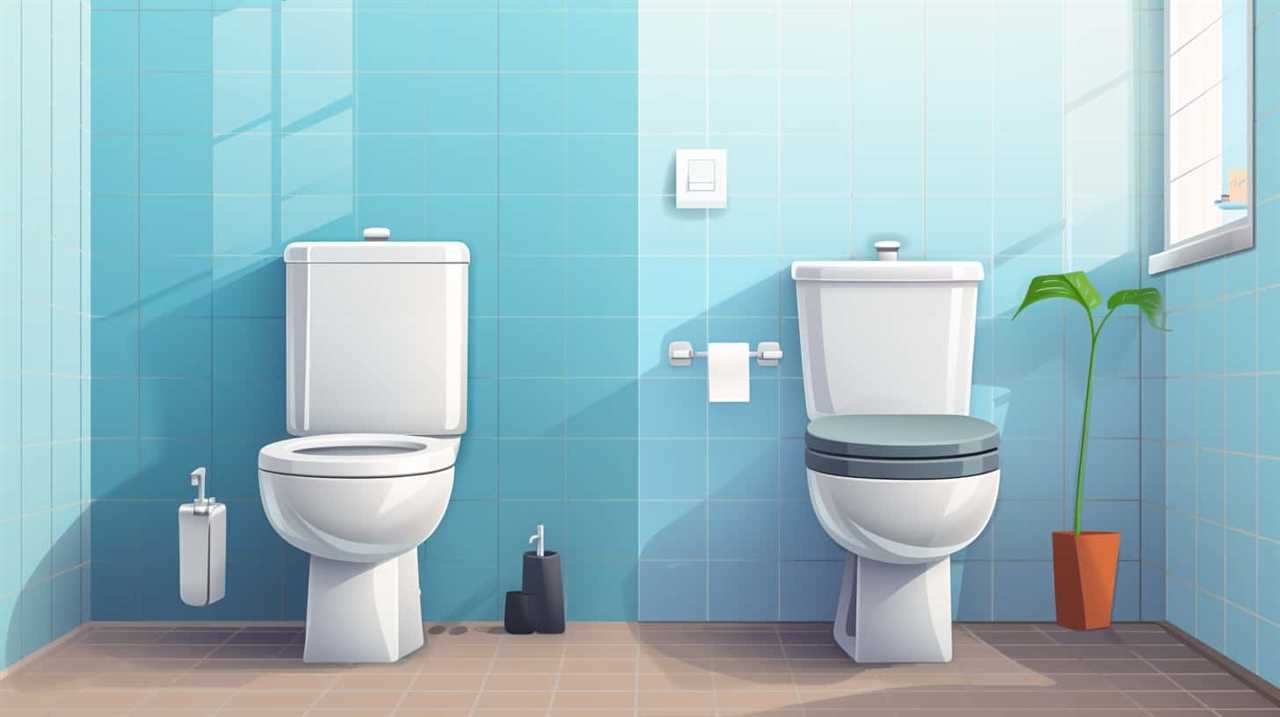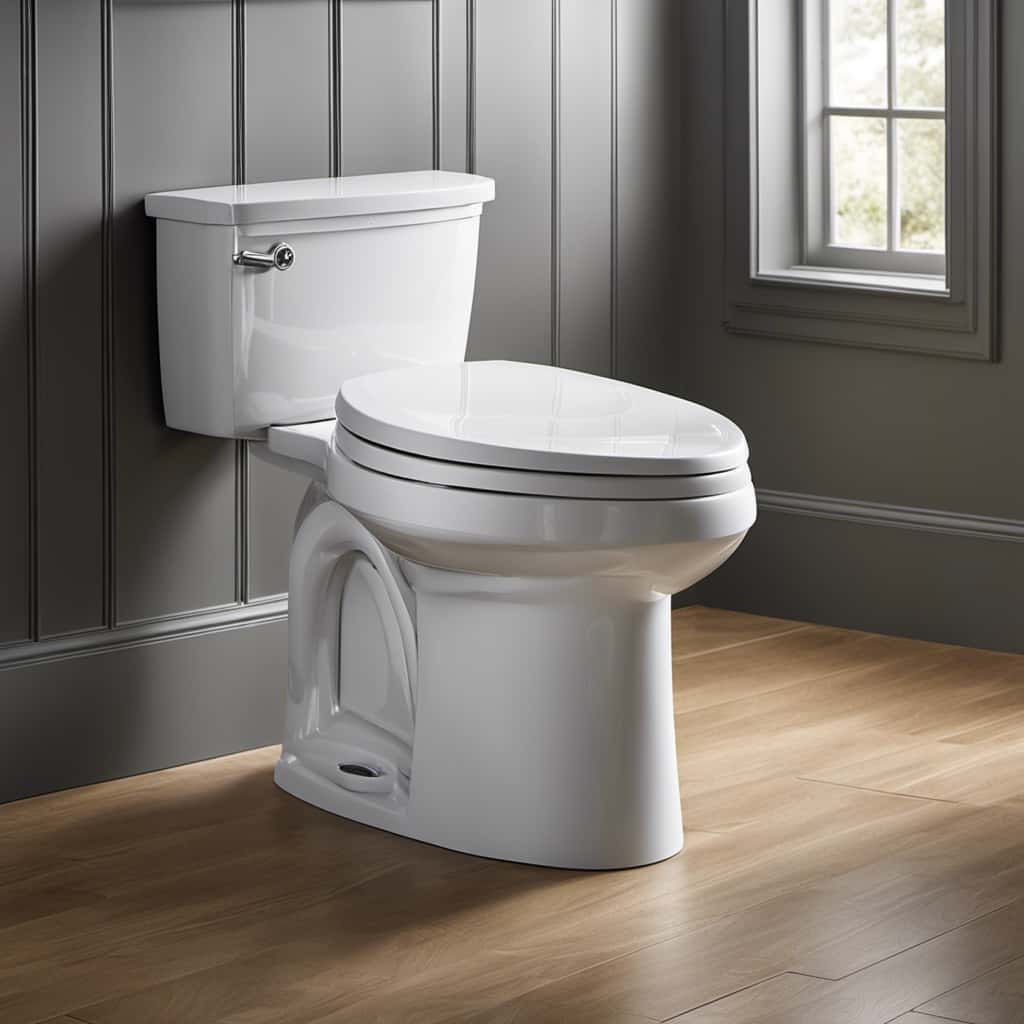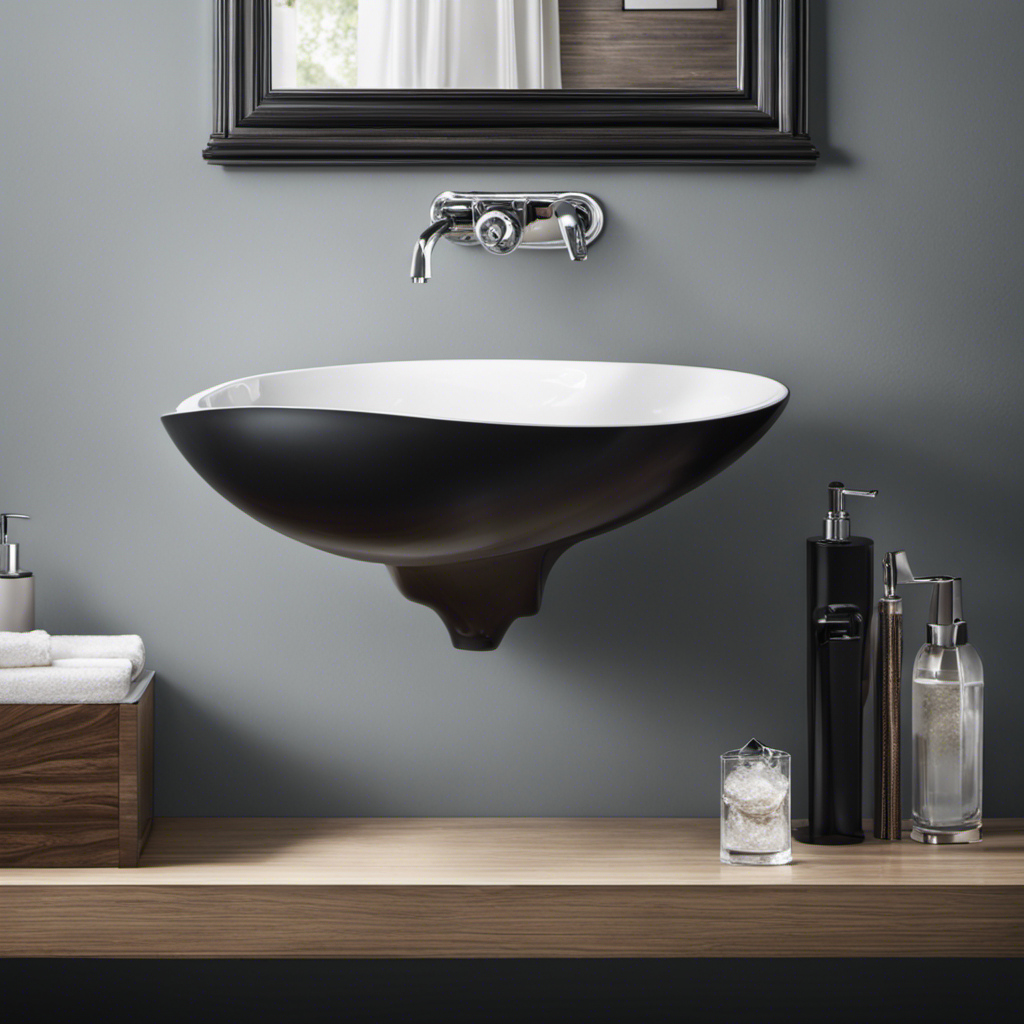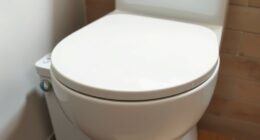Fed up with feeble toilet flushes? Worry no more, as we have the perfect solution for you.
In this article, we’re going to show you exactly how to make your toilet flush stronger.
From adjusting the water level to unclogging those pesky jet holes, we’ve got all the tips and tricks you need.
So get ready to master the art of the powerful flush and bid farewell to those weak flushes once and for all.
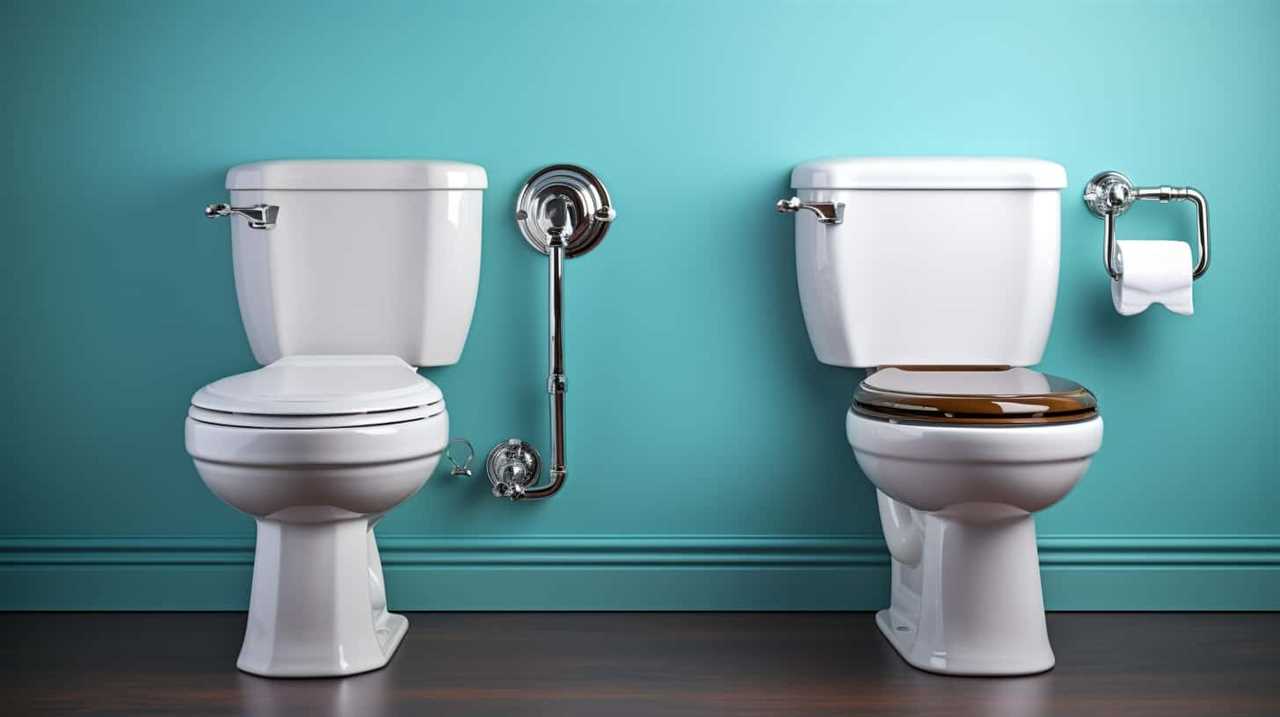
Let’s dive in!
Key Takeaways
- Adjusting the water level is crucial for troubleshooting weak flushes.
- Clean or replace the flapper to ensure proper water release from the tank into the bowl.
- Unclog jet holes to restore water pressure and improve flushing power.
- Consider upgrading to a dual flush converter or pressure-assisted flush for stronger flushes and improved toilet performance.
Check Water Level and Adjust
To check the water level and make adjustments, we need to start by locating the water level adjustment screw. This screw is usually found on the fill valve, which is connected to the water supply line.
Adjusting the water level is crucial for troubleshooting weak flushes. When the water level is too low, there may not be enough water to adequately flush waste down the drain. Conversely, if the water level is too high, it can result in constant overflow or even leaks.
To adjust the water level, turn the adjustment screw clockwise to increase the water level or counterclockwise to decrease it. It’s important to make small adjustments and test the flush after each adjustment until the desired strength is achieved.

Clean or Replace the Flapper
After checking the water level and making adjustments, we can now move on to cleaning or replacing the flapper.
The flapper is an essential component of the toilet’s flush system, as it controls the release of water from the tank into the bowl. Over time, the flapper can become worn or dirty, resulting in a weaker flush.
To address this issue, first, turn off the water supply to the toilet. Then, remove the tank lid and locate the flapper. Inspect the flapper for any signs of damage or debris. If it’s merely dirty, clean it with a mild detergent and a soft brush. If the flapper is damaged, it’s best to replace it with a new one.
When installing a new flapper, adjust the chain length to ensure proper functioning. Finally, clean the fill valve to complete the maintenance process.

Regularly cleaning or replacing the flapper will help maintain a strong and efficient flush.
Unclog the Jet Holes
Now, let’s address the next step in improving your toilet’s flush strength by unclogging the jet holes. To increase water pressure and ensure an effective flush, it is important to keep the jet holes clean and free from any blockages. Jet holes are small openings located under the rim of the toilet bowl that direct water into the bowl when you flush. Over time, these holes can become clogged with mineral deposits, debris, or even mold. To unclog the jet holes, you can use a plunger effectively by creating a seal around the hole and applying pressure to dislodge any obstructions. This will help to restore the proper water flow and improve the flushing power of your toilet.
| Step | Instructions |
|---|---|
| 1 | Put on rubber gloves. |
| 2 | Locate the jet holes under the rim. |
| 3 | Use a plunger to create a seal around each jet hole. |
| 4 | Plunge vigorously to dislodge any blockages. |
Now that we have learned how to unclog the jet holes, let’s move on to the next step: installing a dual flush converter.
Install a Dual Flush Converter
To improve the flushing power of our toilet, we can now explore the installation of a dual flush converter. This converter allows you to choose between a partial flush for liquid waste and a full flush for solid waste, optimizing water usage and enhancing flushing efficiency.

Here are some key benefits of installing a dual flush converter:
- Water conservation: With the ability to select the appropriate flush option, you can reduce water consumption significantly.
- Cost savings: By using less water per flush, you can save money on your water bill.
- Easy installation: Installing a dual flush converter is a straightforward process that doesn’t require extensive plumbing knowledge.
- Replace fill valve: During the installation, you can also replace the fill valve, ensuring proper water flow and preventing leaks.
- Adjust water pressure: With a dual flush converter, you can adjust the water pressure to achieve the desired flushing power.
Consider Upgrading to a Pressure-Assisted Flush
Let’s explore upgrading to a pressure-assisted flush to further enhance the flushing power of our toilet. A pressure-assisted flush system uses compressed air to create a strong, forceful flush that efficiently clears waste from the bowl. This type of flush system offers several benefits over a gravity-fed flush system. Firstly, it provides a higher level of flushing power, ensuring that waste is effectively removed with each flush. Additionally, pressure-assisted flush toilets are less prone to clogs, reducing the need for plunging or snaking. However, it’s important to be aware of some common issues that can arise with pressure-assisted flush toilets. These include noise during flushing, potential for leaks, and the need for regular maintenance to prevent any malfunctions. Overall, upgrading to a pressure-assisted flush can significantly improve the performance of your toilet.
| Benefits of using a gravity fed flush system | Common issues with pressure assisted flush toilets |
|---|---|
| – Simplicity and reliability | – Noise during flushing |
| – Lower cost | – Potential for leaks |
| – Easy to repair | – Regular maintenance requirements |
| – Less prone to malfunctions | – Higher initial cost |
| – Water efficient | – Limited design options |
Frequently Asked Questions
Can I Use Any Type of Toilet Paper With a Stronger Flush, or Is There a Specific Type That Works Best?
Using different types of toilet paper may affect flush strength, but there isn’t a specific type that guarantees a stronger flush. To troubleshoot weak flushes, consider checking water supply, adjusting flapper valve, or clearing clogs.
Will Adjusting the Water Level in My Toilet Tank Affect the Overall Water Usage in My Home?
Adjusting the water level in our toilet tank will impact our water bill and consumption. By finding the optimal level, we can ensure efficient flushing while minimizing unnecessary water usage.

How Often Should I Clean or Replace the Flapper to Maintain a Strong Flush?
To maintain a strong flush, it is important to clean or replace the flapper regularly. For cleaning, disconnect the flapper and scrub it with a brush. To replace, turn off the water supply, detach the old flapper and install a new one.
Are There Any Household Items That Can Be Used to Unclog the Jet Holes Before Resorting to Professional Help?
Household items like a wire hanger or vinegar can be used to unclog jet holes before calling a professional. These simple techniques are effective and can save you time and money.
What Is the Average Cost and Difficulty Level of Installing a Dual Flush Converter in a Toilet?
The average cost and difficulty level of installing a dual flush converter in a toilet vary depending on the brand and model. It is important to research and consult professionals for accurate estimates and guidance.
Conclusion
In conclusion, improving the flush strength of your toilet can be achieved by adjusting the water level. Cleaning or replacing the flapper is another effective method. Unclogging the jet holes is also a recommended technique. Installing a dual flush converter or upgrading to a pressure-assisted flush are additional options to consider. By implementing these techniques, your toilet will flush with the force of a rushing river, ensuring effective waste removal.
